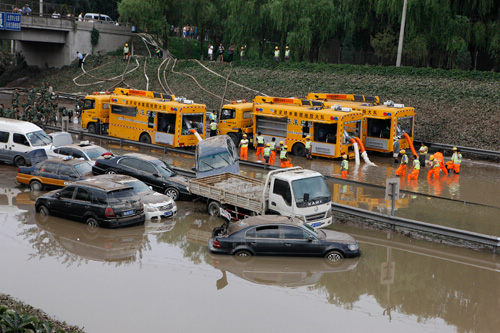|
 |
|
LONG RESCUE EXPRESS: Workers and soldiers pump water out of a submerged section of the Beijing-Hong Kong-Macao Expressway the day after the flood on July 22 (CFP) |
A 900-meter-long section of the Beijing-Hong Kong-Macao Expressway accumulated 200,000 cubic meters of floodwaters after a nearby dike broke following hours of continuous rain, an amount equivalent to a small reservoir, and dozens of vehicles were submerged beneath an average of four meters of water.
Divers from fire departments and the Bluesky rescue team of the Beijing Red Cross Foundation rushed to the flooded road section and started search and rescue work in the rain. The divers worked 10 hours continuously in the cold, muddy water.
"The underwater visibility was nearly to zero and we could only position and count the submerged autos with our bare hands. Most of us were cut by the broken glass," said Wang Liang, a member of the Bluesky rescue team.
"With one hand protecting my face, I used the other fist to pull the mud underground and move forward. A robe was linking my waist and other crew members on the boat," said another diver Hu Xipeng.
With the efforts of over 500 rescuers, a 1-km-long drainage canal was dug to drain the floods into the groundwork of an under-construction sewage treatment plant nearby.
Traffic on the Beijing-Hong Kong-Macao Expressway resumed on July 24 after divers removed 81 stranded vehicles.
Lessons to learn
Shocked by the huge casualties in the rains on July 21, Zheng Yuanjie, a well-known author of children's books, said in a Weibo post that if the authorities had sent out warnings promptly, people's lives might have been saved.
In fact, the authorities had been preparing for a plan for the storm a week before and issued rainstorm alert warnings prior to the downpours, according to the Beijing Meteorological Bureau. However, many residents said they did not receive any warning messages and some other complained that the early warnings were too vague and hoped for detailed explanation of the disasters behind the warnings.
"While issuing warnings, the government should also warn residents to stay indoors through text messages and inform drivers of flooded road sections," said Shi Anbin, a professor at Tsinghua University.
In response, Qu Xiaobo, Deputy Director of the Beijing Meteorological Bureau, said on July 22 that it was technically impossible to send so many short messages within a short time, as there are limited base stations in Beijing.
However, Qu's comments were denied by mobile network operators, which said that there are no obstacles in sending short messages en masse.
"The ultimate problem, however, is not whether the authorities have sent text messages. Even if everybody received a text, they would still have to face a problematic drainage system that caused flooding in the city," said Zhang Xin, an associate professor at the School of Public Administration of Renmin University of China.
| 